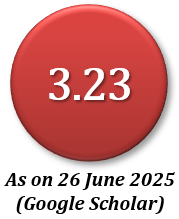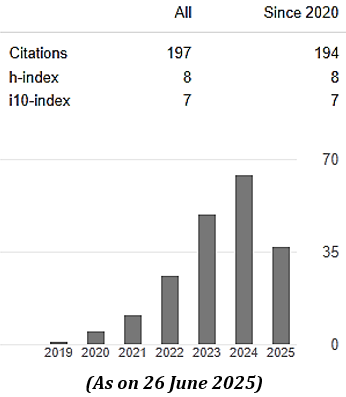Bankline Assessment of Shibsa-Passur River by Satellite Imagery and Hydrodynamic Modeling using Delft3D
Abstract
The Sundarbans, a prolific mangrove wetland ecosystem part of the world's largest delta formed by the Ganges, Brahmaputra, and Meghna rivers, contribute immensely to coastal stability and protection. In deltaic mangroves such as the Sundarbans, recurrent erosion and accretion caused by the transportation of unconsolidated sediments by rivers, interact with flow velocity and bed shear to generate continuous morphological dynamics. This study analyzed the bankline migration patterns of the Shibsa and Passur rivers within the Bangladesh portion of the Sundarbans using satellite images and assessed their hydrodynamic behavior by developing a two-dimensional model using Delft3D. This study utilized Landsat and Sentinel images from 2009-2021 to identify critical erosion and deposition zones applying the DSAS tool of ArcGIS. A two-dimensional hydrodynamic model was then developed and calibrated to simulate flow velocity, bed shear stress, and water levels in these critical zones. The model was validated against limited available water level data. Six critical zones were identified, with four erosion-prone and two deposition-prone areas. The model results indicated increased velocities and bed shear stresses in the erosion zones relative to non-critical areas, while the deposition zones experienced reduced velocities and bed shear stresses. The study reveals that the high values of velocity and bed shear stresses are responsible for the morphological changes of erosion, thus emphasizing the significance of close monitoring with remotely sensed images.
Downloads
References
Abu Hanipah, A. H., Guo, Z. R., & Zahran, E. S. M. M. (2018). Hydrodynamic Modeling of a River with Mangrove Forests. 7th Brunei International Conference on Engineering and Technology 2018 (BICET 2018). DOI: 10.1049/cp.2018.1511.
Alam, S., & Matin, M. A. (2013). Application of 2D morphological model to assess the response of Karnafuli River due to capital dredging. Journal of Water Resources and Ocean Science, 2(3), 40-48. DOI: 10.11648/j.wros.20130203.13
Amanambu, A. C., & Mossa, J. (2024). Machine learning insights of anthropogenic and natural influences on riverbed deformation in a large lowland river. Geomorphology, 446, 108986. DOI: 10.1016/j.geomorph.2023.108986
Anam, M. M., Jabir, A. A., & Hasan, G. M. J. (2021). Bank-Line Behaviour of the Main Rivers Located within Sundarbans Using Digital Shoreline Analysis System. MIST International Journal of Science and Technology, 9. DOI: 10.47981/j.mijst.09(01)2021.288(11-21)
Ashraf, M. & Shakir, A. S. (2018). Prediction of River Bank Erosion and Protection Works in a Reach of Chenab River, Pakistan. Arabian Journal of Geosciences, 11(7). DOI: 10.1007/s12517-018-3493-7.
Avila, H., Cuervo, G. H., & Daza, R. (2014). Susceptibility Analysis of River Bank Erosion Based on Exposure to Shear Stress and Velocity Combined with Hydrologic and Geomorphologic Variables. World Environmental and Water Resources Congress 2014. DOI:10.1061/9780784413548.154
Briaud J. L. (2008). Case Histories in Soil and Rock Erosion: Woodrow Wilson Bridge, Brazos River Meander, Normandy Cliffs, and New Orleans Levees. The 9th Ralph B. Peck Lecture, Journal of Geotechnical and Geoenvironmental Engineering, 134(10), ASCE, Reston, Virginia, USA.
Bristow, C. S. (1987). Brahmaputra River: Channel Migration and Deposition. The Society of Economic Paleontologists and Mineralogists (SEPM), Recent Developments in Fluvial Sedimentology (SP39), 1987. DOI:10.2110/pec.87.39.0063.
Chakraborty, M., Sriram, V., & Murali, K. (2022). Impact of the ship waves and tidal forces on the sediment resuspension in inland waterways. Coastal Engineering Proceedings, (37), 52-52. DOI: 10.9753/icce.v37.papers.52
Chakraborty, M., Sriram, V., & Murali, K. (2024). Investigation of ship-induced hydrodynamics and sediment resuspension in a restricted waterway. Applied Ocean Research, 142, 103831. DOI: 10.1016/j.apor.2023.103831
Das, T. K., Halder, S. K., Gupta, I. D., & Sen, S. (2014). River Bank Erosion Induced Human Displacement and Its Consequences. Living Reviews in Landscape Research, 8(3), 1-35. DOI: 10.12942/lrlr-2014-3.
Ghosh, D. & Sahu, A. S. (2018). Problem of River Bank Failure and the Condition of the Erosion Victims: A Case Study in Dhulian, West Bengal, India. Regional Science Inquiry, 10(2), 205-214.
Giri, C., Pengra, B. W., Zhu Z., Singh A., & Tieszen L. L. (2007). Monitoring Mangrove Forest Dynamics of the Sundarbans in Bangladesh and India Using Multi-Temporal Satellite Data from 1973 to 2000. Estuarine, Coastal and Shelf Science, 73(1-2), 91-100. DOI: 10.1016/j.ecss.2006.12.019
Habibullah, M. (1987). Computer Modeling of River Chanel Changes in Alluvial Condition. First Interim Report R 02/87, IFCDR, BUET, Dhaka.
Haque, A., Sumaiya, & Rahman, M. (2016). Flow distribution and sediment transport mechanism in the estuarine systems of Ganges-Brahmaputra-Meghna delta. International Journal of Environmental Science and Development, 7(1), 22-30. DOI: 10.7763/IJESD.2016.V7.735
Hasan, G.M.J., & Matin, N. (2019). Estimation of Areal Changes along the Coastline of Bangladesh due to Erosion and Accretion. International Journal of Engineering Sciences 12(3), 111-117. DOI: 10.36224/ijes.120305
Hasanuzzaman, M., Bera, B., Islam, A. & Shit, P. K. (2021). Estimation and Prediction of Riverbank Erosion Susceptibility and Shifting Rate Using DSAS, BEHI, and REBVI Models: Evidence from the Lower Ganga River in India. https://doi.org/10.21203/rs.3.rs-1097959/v1
Hassan, A., Hoque, I., Huq, P. A. K., Martin, T. C., Nishat, A., & Thorne, C. R. (1997). Defining the banklines of Brahmaputra-Jamuna River using satellite imagery. In Proceedings of the 3rd International Conference on River Flood Hydraulics, Oxford, 349-358.
Hossain, S. & Yeham (2014). A Study on Morphological Change of Meghna River Due to Climate Change by Using GIS Map Analysis. 2nd international Conference on Advances in Civil Engineering 2014 (ICACE-2014), ID: WRE051.
Ikeda, S., & Parker, G. (1989). River Meandering. American Geophysical Union: Water Resources Monograph, 12, 321–378. DOI: 10.1029/WM012
Islam, M. S. & Wahab, M. A. (2005). A Review on the Present Status and Management of Mangrove Wetland Habitat Resources in Bangladesh with Emphasis on Mangrove Fisheries and Aquaculture. Hydrobiologia, 542, 165-190.
Islam, M. F., Schot, P. P., Dekker, S. C., Griffioen, J., & Middelkoop, H. (2022). Physical controls and a priori estimation of raising land surface elevation across the southwestern Bangladesh delta using tidal river management. Hydrology and Earth System Sciences, 26(4), 903-921. DOI: 10.5194/hess-26-903-2022
Jana, S. (2019). An Automated Approach Estimation and Prediction of Riverbank Shifting for Flood-Prone Middle-Lower Course of the Subarnarekha River, India. International Journal of River Basin Management, 1-19. DOI: 10.1080/15715124.2019.1695259.
Jackson, R. G. (1976). Depositional model of point bars in the lower Wabash River. Journal of Sedimentary Research, 46(3), 579-594.
Kobashi, D., & Mazda, Y. (2005). Tidal flow in riverine-type mangroves. Wetlands Ecology and Management, 13, 615-619.
Laz, O. U. (2012). Morphological Assessment of a Selected Reach of Jamuna River by Using Delft3D Model. M.Sc. Engineering Thesis, Department of Water Resources Engineering, BUET, Dhaka.
Lotsari, E., Wainwright, D. J., Corner, G. D., Alho, P., and Kayhko, J. (2014). Surveyed and Modelled One-Year Morphodynamics in the Braided Lower Tana River. Hydrological Processes, 28(4), 2685–2716. DOI: 10.1002/hyp.9750
Markham, B. L., Dabney, P. W., Storey, J. C., Morfitt, R., Knight, E., Kvaran, G., & Kenton, L. (2008). Landsat Data Continuity Mission Calibration and Validation. The 17th William T. Pecora Memorial Remote Sensing Symposium, Denver, Colorado.
Mazda, Y., Kanazawa, N., & Wolanski, E. (1995). Tidal asymmetry in mangrove creeks. Hydrobiologia, 295, 51-58.
Menezes, D. B., Toyama, D., & Bahia, C. B. (2024). Sediment Profiles and Recording the Effects of Anthropogenic Activities. Sediment Transport Research - Further Recent Advances. IntechOpen. DOI: 10.5772/intechopen.1001488
Midha, N. & Mathur, P. K. (2014). Channel Characteristics and Planform Dynamics in the Indian Terai, Sharda River. Environmental Management, 53, 120-134.
Momen, M.A., Uddin, M.E., & Tasnim, N. (2020). Assessment of Bank Erosion and Accretion of Jamuna River Using GIS and Remote Sensing, Conference: 5th International Conference on Advances in Civil Engineering (ICACE-2020) at CUET, Chattogram, Bangladesh. 8p.
Nelson, J. M., & Smith, J. D. (1989). Evolution and Stability of Erodible Channel Beds. River Meandering, chapter 11, pp. 321-377, DOI: 10.1029/WM012p0321
Nicholas, A. (2012). Numerical simulation of morphodynamic diversity in the World's largest rivers. In EGU General Assembly Conference Abstracts, 5989.
Nicholas, A. (2013a). Morphodynamic Diversity of the World's Largest Rivers. Geology, 41(4), 475-478. DOI: 10.1130/G34016.1
Nicholas, A. (2013b). Modelling the Continuum of River Channel Patterns. Earth Surface Processes and Landforms, 38(10), 1187–1196. DOI: 10.1002/esp.3431
Petts, G. E. & Gurnell, A. M. (2005). Dams and Geomorphology: Research Progress and Future Directions. Geomorphology, 71, 27-47.
Rahman, M. M. (2012). Time-series Analysis of Coastal Erosion in The Sundarbans Mangrove. International Archives of the Photogrammetry, Remote Sensing and Spatial Information Sciences, 39(B8), 425-429.
Ramos, J. & Gracia, J. (2012). Spatial–temporal Fluvial Morphology Analysis in the Quelite River: It's Impact on Communication Systems. Journal of Hydrology, 412, 269-278. DOI: 10.1016/j.jhydrol.2011.05.007
Sadeghi, V., Ebadi, H., & Ahmadi, F.F. (2013). A New Model for Automatic Normalization of Multitemporal Satellite Images Using Artificial Neural Network and Mathematical Methods. Applied Mathematical Modelling, 37(9), 6437-6445. https://doi.org/10.1016/j.apm.2013.01.006
Sohel, M.I.S., Hore, S.H., Salam, M.A., Hoque, M.A., Ahmed, N., Rahman, M., Khan, M., & Rahman, S. (2021). Analysis of Erosion-Accretion Dynamics of Major Rivers of World's Largest Mangrove Forest using Geospatial Techniques. Regional Studies in Marine Science. DOI: 10.1016/j.rsma.2021.101901
Sun, T., Meakin, P., & Jøssang, T. (2001), A computer Model for Meandering Rivers with Multiple Bed Load Sediment Sizes 2. Computer simulations: Water Resources Research, 37, 2243–2258. DOI: 10.1029/2000WR900397.
Thieler, E. R., Himmelstoss, E. A., Zichichi, J. L. & Ergul, A. (2009). Digital Shoreline Analysis System (DSAS) version 4.0 — An ArcGIS extension for calculating shoreline change. U.S. Geological Survey Open-File Report 2008-1278.
Uddin, K., Shrestha, B. & Alam, M.S. (2011). Assessment of Morphological Changes and Vulnerability of River Bank Erosion alongside the River Jamuna Using Remote Sensing. Journal of Earth Science and Engineering, 1, 29-34.
Wahid, S.M., Babel, M.S., & Bhuiyan, A.R. (2007). Hydrologic Monitoring and Analysis in the Sundarbans Mangrove Ecosystem, Bangladesh. Journal of Hydrology, 332(3-4), 381-395. DOI: 10.1016/j.jhydrol.2006.07.016
WCMC (2005). Protected Areas Database. UNEP World Conservation Monitoring Centre. 70p.
Winterbottom, S. J. (2000). Medium and Short-Term Channel Planform Changes on the Rivers Tay and Tummel, Scotland. Geomorphology, 34, 195-208.
MIJST follows the open access policy.

This work is licensed under a Creative Commons Attribution-NonCommercial 4.0 International License. This allows anyone to copy, share, distribute, and modify the work for non-commercial purposes, where the original work and source should be properly credited.
















